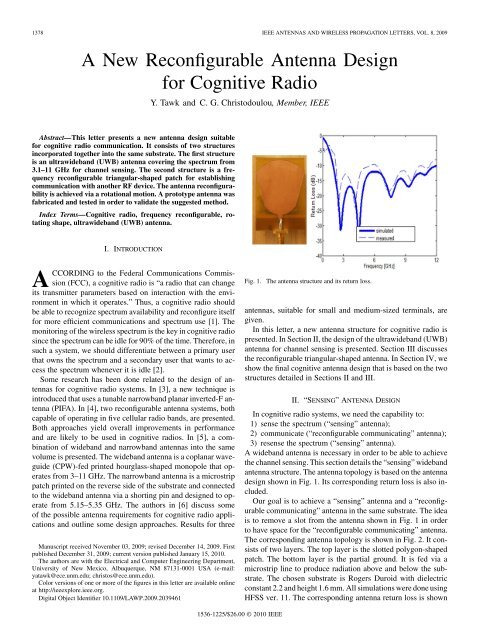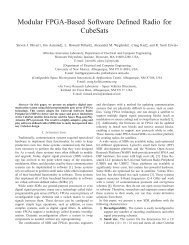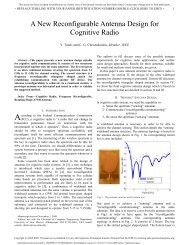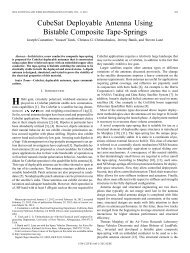A New Reconfigurable Antenna Design for Cognitive Radio
A New Reconfigurable Antenna Design for Cognitive Radio
A New Reconfigurable Antenna Design for Cognitive Radio
Create successful ePaper yourself
Turn your PDF publications into a flip-book with our unique Google optimized e-Paper software.
1378 IEEE ANTENNAS AND WIRELESS PROPAGATION LETTERS, VOL. 8, 2009<br />
A <strong>New</strong> <strong>Reconfigurable</strong> <strong>Antenna</strong> <strong>Design</strong><br />
<strong>for</strong> <strong>Cognitive</strong> <strong>Radio</strong><br />
Y. Tawk and C. G. Christodoulou, Member, IEEE<br />
Abstract—This letter presents a new antenna design suitable<br />
<strong>for</strong> cognitive radio communication. It consists of two structures<br />
incorporated together into the same substrate. The first structure<br />
is an ultrawideband (UWB) antenna covering the spectrum from<br />
3.1–11 GHz <strong>for</strong> channel sensing. The second structure is a frequency<br />
reconfigurable triangular-shaped patch <strong>for</strong> establishing<br />
communication with another RF device. The antenna reconfigurability<br />
is achieved via a rotational motion. A prototype antenna was<br />
fabricated and tested in order to validate the suggested method.<br />
Index Terms—<strong>Cognitive</strong> radio, frequency reconfigurable, rotating<br />
shape, ultrawideband (UWB) antenna.<br />
I. INTRODUCTION<br />
ACCORDING to the Federal Communications Commission<br />
(FCC), a cognitive radio is “a radio that can change<br />
its transmitter parameters based on interaction with the environment<br />
in which it operates.” Thus, a cognitive radio should<br />
be able to recognize spectrum availability and reconfigure itself<br />
<strong>for</strong> more efficient communications and spectrum use [1]. The<br />
monitoring of the wireless spectrum is the key in cognitive radio<br />
since the spectrum can be idle <strong>for</strong> 90% of the time. There<strong>for</strong>e, in<br />
such a system, we should differentiate between a primary user<br />
that owns the spectrum and a secondary user that wants to access<br />
the spectrum whenever it is idle [2].<br />
Some research has been done related to the design of antennas<br />
<strong>for</strong> cognitive radio systems. In [3], a new technique is<br />
introduced that uses a tunable narrowband planar inverted-F antenna<br />
(PIFA). In [4], two reconfigurable antenna systems, both<br />
capable of operating in five cellular radio bands, are presented.<br />
Both approaches yield overall improvements in per<strong>for</strong>mance<br />
and are likely to be used in cognitive radios. In [5], a combination<br />
of wideband and narrowband antennas into the same<br />
volume is presented. The wideband antenna is a coplanar waveguide<br />
(CPW)-fed printed hourglass-shaped monopole that operates<br />
from 3–11 GHz. The narrowband antenna is a microstrip<br />
patch printed on the reverse side of the substrate and connected<br />
to the wideband antenna via a shorting pin and designed to operate<br />
from 5.15–5.35 GHz. The authors in [6] discuss some<br />
of the possible antenna requirements <strong>for</strong> cognitive radio applications<br />
and outline some design approaches. Results <strong>for</strong> three<br />
Manuscript received November 03, 2009; revised December 14, 2009. First<br />
published December 31, 2009; current version published January 15, 2010.<br />
The authors are with the Electrical and Computer Engineering Department,<br />
University of <strong>New</strong> Mexico, Albuquerque, NM 87131-0001 USA (e-mail:<br />
yatawk@ece.unm.edu; christos@ece.unm.edu).<br />
Color versions of one or more of the figures in this letter are available online<br />
at http://ieeexplore.ieee.org.<br />
Digital Object Identifier 10.1109/LAWP.2009.2039461<br />
Fig. 1.<br />
The antenna structure and its return loss.<br />
antennas, suitable <strong>for</strong> small and medium-sized terminals, are<br />
given.<br />
In this letter, a new antenna structure <strong>for</strong> cognitive radio is<br />
presented. In Section II, the design of the ultrawideband (UWB)<br />
antenna <strong>for</strong> channel sensing is presented. Section III discusses<br />
the reconfigurable triangular-shaped antenna. In Section IV, we<br />
show the final cognitive antenna design that is based on the two<br />
structures detailed in Sections II and III.<br />
II. “SENSING” ANTENNA DESIGN<br />
In cognitive radio systems, we need the capability to:<br />
1) sense the spectrum (“sensing” antenna);<br />
2) communicate (“reconfigurable communicating” antenna);<br />
3) resense the spectrum (“sensing” antenna).<br />
A wideband antenna is necessary in order to be able to achieve<br />
the channel sensing. This section details the “sensing” wideband<br />
antenna structure. The antenna topology is based on the antenna<br />
design shown in Fig. 1. Its corresponding return loss is also included.<br />
Our goal is to achieve a “sensing” antenna and a “reconfigurable<br />
communicating” antenna in the same substrate. The idea<br />
is to remove a slot from the antenna shown in Fig. 1 in order<br />
to have space <strong>for</strong> the “reconfigurable communicating” antenna.<br />
The corresponding antenna topology is shown in Fig. 2. It consists<br />
of two layers. The top layer is the slotted polygon-shaped<br />
patch. The bottom layer is the partial ground. It is fed via a<br />
microstrip line to produce radiation above and below the substrate.<br />
The chosen substrate is Rogers Duroid with dielectric<br />
constant 2.2 and height 1.6 mm. All simulations were done using<br />
HFSS ver. 11. The corresponding antenna return loss is shown<br />
1536-1225/$26.00 © 2010 IEEE
TAWK AND CHRISTODOULOU: A NEW RECONFIGURABLE ANTENNA DESIGN FOR COGNITIVE RADIO 1379<br />
Fig. 4. The normalized antenna radiation pattern <strong>for</strong> a set of frequencies.<br />
Fig. 2. The “sensing” antenna structure.<br />
Fig. 3. The return loss <strong>for</strong> the sensing antenna structure.<br />
Fig. 5. The “reconfigurable communicating” antenna structure.<br />
in Fig. 3. It shows coverage from 3.3–11 GHz, making it suitable<br />
<strong>for</strong> channel sensing in cognitive radio systems.<br />
For an antenna to be suitable <strong>for</strong> channel sensing, it should<br />
possess an omnidirectional radiation pattern. The antenna structure<br />
investigated in this section satisfies this requirement. The<br />
computed radiation pattern in the X-Z plane at 4.5 (thin line),<br />
7.5 (thick line), and 10.5 GHz (dotted line) is shown in Fig. 4.<br />
It is essential to note that the addition of the rounded shape<br />
just after the stripline feed-line is responsible <strong>for</strong> producing the<br />
required wide bandwidth <strong>for</strong> the antenna. This rounded shape<br />
has the effect of making the antenna input impedance close to<br />
50 <strong>for</strong> the band from 3.3–11 GHz. This antenna structure also<br />
shows a resonance at 1.9 GHz.<br />
III. “RECONFIGURABLE COMMUNICATING” ANTENNA DESIGN<br />
In this section, the structure <strong>for</strong> the “reconfigurable communicating”<br />
antenna is detailed. <strong>Reconfigurable</strong> antennas<br />
have drawn considerable attention, especially <strong>for</strong> broadband<br />
wireless communication, space-time adaptive processing,<br />
multiple-input–multiple-output (MIMO) systems, and cognitive<br />
radio. The reconfigurability is achieved by using active<br />
switches. These switches or tuning elements can be fabricated<br />
from several technologies (microelectromechanical systems<br />
(MEMS)-based, a combination of MEMS and electronic<br />
band-gaps materials, piezoelectric transducers, p-i-n diodes,<br />
lumped elements, and photoconductive). In this work, we<br />
suggest a new way to implement frequency reconfigurable<br />
antenna design. A rotating part of the antenna is responsible to<br />
produce the required frequency tuning [7]. The advantage of<br />
this method is that no biasing circuits <strong>for</strong> switch activation are<br />
needed, which might affect the antenna per<strong>for</strong>mance.<br />
The “reconfigurable communicating” antenna structure<br />
is summarized in Fig. 5. By rotating the antenna patch by<br />
180 , a different structure is being fed by the microstrip line.<br />
This rotation will produce different resonances, making the<br />
antenna suitable to communicate at the frequency specified<br />
by the “sensing” antenna. The antenna top layer consists of
1380 IEEE ANTENNAS AND WIRELESS PROPAGATION LETTERS, VOL. 8, 2009<br />
Fig. 6. The process of rotation.<br />
Fig. 8. The normalized radiation pattern <strong>for</strong> positions 1 and 2.<br />
Fig. 7. Frequency tuning <strong>for</strong> the “reconfigurable communicating” antenna.<br />
two triangular-shaped patches that are separated by a given<br />
distance. Similar to the “sensing” antenna, this structure is<br />
fed via a microstrip line and has a partial ground. Since this<br />
antenna is going to be incorporated with the “sensing” antenna,<br />
its substrate size was taken to be the same as the “sensing”<br />
antenna. Its ground dimension is taken to be 18 mm 9mm<br />
so that it will not affect the radiation from the patch of the<br />
“sensing” antenna. The process of rotation is shown in Fig. 6;<br />
the structure shown in the left corresponds to position 1, and<br />
the structure shown in the right corresponds to position 2.<br />
The frequency reconfigurability of this antenna can be noticed<br />
by comparing the return loss plot presented in Fig. 7. This<br />
antenna has the property to tune from 5.3–9.15 GHz (position 1)<br />
to 3.4–4.85 GHz (position 2). The computed radiation pattern<br />
in the X-Z plane at 6.65 GHz <strong>for</strong> position 1 (thick line) and at<br />
4 GHz <strong>for</strong> position 2 (thin line) is shown in Fig. 8. For both positions,<br />
the antenna satisfies the omnidirectional property.<br />
IV. COGNITIVE ANTENNA DESIGN<br />
In the previous two sections, we have separately discussed<br />
the design of the “sensing” and the “reconfigurable communicating”<br />
antenna. In this section, we incorporate both designs into<br />
the same antenna susbtrate. This has the advantage of reducing<br />
space requirements and making the two antennas required <strong>for</strong><br />
cognitive radio communication lie in the same plane.<br />
The suggested antenna structure is provided in Fig. 9. The<br />
dimensions of the different parts of the antenna are the same<br />
Fig. 9.<br />
Fig. 10.<br />
The cognitive antenna structure.<br />
The fabricated antenna prototype.<br />
as those mentioned in the previous two sections. The fabricated<br />
prototype is shown in Fig. 10.<br />
The comparison between the simulated and the measured return<br />
loss <strong>for</strong> the “sensing” antenna is shown in Fig. 11. This data<br />
is <strong>for</strong> the antenna at position 1. The same return loss is produced<br />
<strong>for</strong> the “sensing” antenna if the entire antenna structure is at position<br />
2.<br />
Fig. 12 shows the measured and the simulated return loss<br />
of the “reconfigurable communicating” antenna <strong>for</strong> both positions.<br />
The required frequency reconfigurability is achieved. The<br />
first plot corresponds to position 2 and covers the band from
TAWK AND CHRISTODOULOU: A NEW RECONFIGURABLE ANTENNA DESIGN FOR COGNITIVE RADIO 1381<br />
Fig. 11. The “sensing” antenna return loss.<br />
Fig. 13.<br />
The antenna coupling <strong>for</strong> both positions.<br />
Fig. 12.<br />
The “reconfigurable communicating” return loss <strong>for</strong> both positions.<br />
3–5 GHz. The second plot corresponds to position 1 and covers<br />
the band from 5– 9 GHz.<br />
Since the “sensing” and the “reconfigurable communicating”<br />
antennas are both incorporated into the same substrate, it is crucial<br />
to look at the coupling between them. For both positions,<br />
the transmission between the two antennas is below dB <strong>for</strong><br />
the whole band of interest. Fig. 13 shows the simulated and the<br />
measured coupling <strong>for</strong> position 1 in the first plot and <strong>for</strong> position<br />
2 in the second plot. The antenna radiation pattern at 3.5<br />
(position 2, thin line), 5.5 (position 2, thick line), 7.5 (position 1,<br />
dotted thin), and 10.5 GHz (position 1, dotted thick) is shown<br />
in Fig. 14.<br />
V. CONCLUSION<br />
In this letter, a new antenna design <strong>for</strong> cognitive radio is discussed.<br />
It consists of two structures. The first one is a wideband<br />
antenna <strong>for</strong> channel sensing. The second structure is a reconfigurable<br />
triangular-shaped patch. Both structures are embedded<br />
into the same susbtrate. A prototype antenna was fabricated<br />
to prove the suggested method. A coupling of less than<br />
-10 dB is shown <strong>for</strong> the entire frequency band. This antenna is<br />
a best candidate <strong>for</strong> future cognitive radio communication. For<br />
future work, one can control the rotation in the “reconfigurable<br />
Fig. 14.<br />
The normalized antenna radiation pattern.<br />
communicating” antenna via a field programmable gate array<br />
(FPGA). Also, the design of the “sensing antenna” can be done<br />
to cover a higher bandwidth MHz GHz .<br />
REFERENCES<br />
[1] FCC Spectrum Policy Task Force, “Report of the Spectrum Efficiency<br />
Working Group,” FCC, Tech. Rep., 2002.<br />
[2] J. Mitola, “<strong>Cognitive</strong> radio: An integrated agent architecture <strong>for</strong> software<br />
defined radio,” Ph.D. dissertation, Royal Institute of Technology<br />
(KTH), Stockholm, Sweden, 2000.<br />
[3] M. Manteghi, “A switch-band antenna <strong>for</strong> software defined radio applications,”<br />
IEEE <strong>Antenna</strong>s Wireless Propag. Lett., vol. 8, pp. 3–5, 2009.<br />
[4] K. R. Boyle et al., “<strong>Reconfigurable</strong> antennas <strong>for</strong> SDR and cognitive<br />
radio,” in Proc. 2nd Eur. Conf. <strong>Antenna</strong>s Propag., Nov. 2007, pp. 1–6.<br />
[5] E. Ebrahimi and P. S. Hall, “A dual port wide-narrowband antenna <strong>for</strong><br />
cognitive radio,” in Proc. 3rd Eur. Conf. <strong>Antenna</strong>s Propag., Mar. 2009,<br />
pp. 809–812.<br />
[6] P. Gardner, M. R. Hamid, P. S. Hall, J. Kelly, F. Ghanem, and E.<br />
Ebrahimi, “<strong>Reconfigurable</strong> antennas <strong>for</strong> cognitive radio: Requirements<br />
and potential design approaches,” in Proc. IET Seminar Wideband,<br />
Multiband <strong>Antenna</strong>s Arrays Defense Civil Appl., Mar. 2008, pp. 89–94.<br />
[7] Y. Tawk and C. G. Christodoulou, “A cellular automata reconfigurable<br />
microstrip antenna design,” in Proc. IEEE <strong>Antenna</strong>s Propag. Soc. Int.<br />
Symp., Jun. 2009, pp. 1–4.










